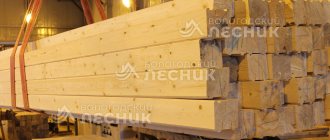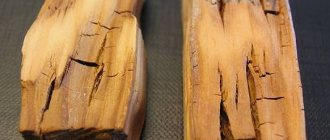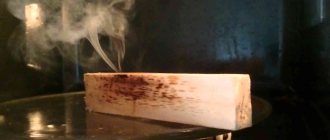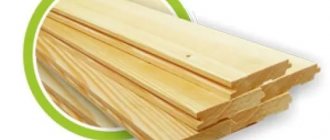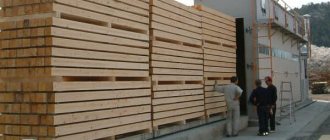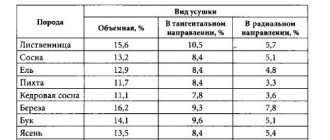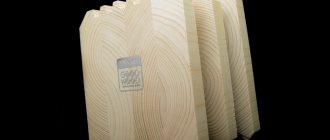Types of moisture for wood
There are two types of humidity of wood raw materials: relative and absolute.
Absolute
This concept is characterized by the ratio of the mass fraction of moisture of a certain volume of wood to the weight of absolutely dry raw materials of the same size. There are established state standards for this indicator. According to them, the indicators of the absolute humidity meter of the board should be within 9%.
Relative
This is the percentage of moisture contained in the wood to the mass of wet wood. In wood raw materials, water is found in two forms: free and bound. They indicate the total amount of moisture in the raw material.
There are several types of wood moisture content:
- Wet. This category includes wood that has been exposed to water for a long time - it is more than 100%.
- Freshly cut. The moisture content of a recently felled tree is between 50-100%.
- Room dry. This type of material that has been in a heated building for a long time - its number is in the range of 9–13%.
- Air dry. This type includes wood that has been stored in the fresh air for a long time - its indicator is in the range of 15–20%.
- Absolutely dry. Such indicators can only be achieved through drying - the amount of water in this case is 0.
What temperature should be in a carpentry workshop?
The air temperature should be maintained at approximately 20 degrees, and the humidity should be between 40-60%.
Interesting materials:
How can I make sure that another person can pick up the parcel? How to make it happen when closing the laptop lid? How can I prevent Windows 10 from turning off when I close my laptop? How can I prevent Firefox from closing when I close the last tab? How can I get notifications in a telegram? How to make the application work in the background of MIUI 12? How to make an application run in the background on Windows? How can I prevent applications from starting automatically? How to make wheat grow faster? How to make the desktop appear in full screen?
Method for determining humidity
The moisture content of wood continuously changes and, depending on the environment, either increases or decreases. If freshly cut wood is placed in water, it will absorb some more water. When exposed to (relatively dry) air for a long time, freshly cut or wet wood loses moisture (free and partly hygroscopic). Humidity is determined using the standard method, drying a wood sample at a temperature of 100-105° to constant weight. Humidity is calculated using the formula:
W = G1 - G2 / G2 x 100
W - wood moisture content in percent; G1—weight of wood sample before drying; G2 is the constant weight of the sample after drying at 100-105°. The moisture content of timber is as follows: freshly cut wood—35% or more; wet (floated) wood - usually higher than the moisture content of freshly cut wood; air-dried wood - 15-20%; room-dry wood - 8-13%.
Wood with a moisture content close to 0%, obtained in the laboratory by drying to a constant weight at 100-105 ° in dry air, is usually called absolutely dry. The conditional standard humidity is 15%, all indicators of physical and mechanical properties when testing wood lead to it.
The state of wood in which it contains only hygroscopic moisture (i.e., the cell walls are maximally saturated with moisture, while their cavities are filled with air) corresponds to the maximum moisture content (Wrрp) or the so-called fiber saturation point. In drying practice, the moment wood reaches the point of fiber saturation is of great importance, since the drying process itself and the beginning of changes in all physical and mechanical properties of wood, depending on humidity, are associated with this. The fiber saturation point varies for different species from 25 to 35% and on average corresponds to about 30% moisture content.
Wood moisture content is the amount of moisture it contains, usually expressed as a percentage of the weight of the sample.
The most commonly used method, included in all existing test standards, is the Besovo method for determining humidity, which according to OST is as follows. From the assortment whose moisture content needs to be determined, a sample is cut out no closer than 0.5 m from the end and 5 mm from the side surfaces.
In felled wood, moisture is a sharply negative factor that has a strong influence on its properties, and for certain operations the temporary presence of moisture is necessary (bending).
The ratio of moisture in a growing tree by month.
Wood moisture table
| Breed | Humidity in% (average over the entire section) | |||||||||||
| Jan. | February | March | Apr | May | June | July | Aug | Sep | Oct | but I | Dec | |
| Pine | 83 | 86 | 89 | 92 | 85 | 84 | 85 | 80 | 84 | 92 | 94 | 97 |
| Spruce | 103 | 105 | 101 | 89 | 83 | 85 | 83 | 78 | 90 | 84 | 82 | 103 |
| Birch | 82 | 86 | 82 | 76 | 92 | 70 | 59 | 60 | 71 | 78 | 82 | 84 |
| Pine | 118 | 107 | 104 | 102 | 91 | 72 | 72 | 64 | 73 | 91 | 91 | 105 |
Water can be contained in wood in two main forms:
- free, or capillary, filling voids inside wood (cell cavities, intercellular spaces),
- bound or hygroscopic, permeating cell walls (between fibrils).
In the sapwood of a growing tree, water is present in both forms, but in the core it only saturates the cell walls. The moisture ratio in a growing tree is characterized by the data (given in Table 2)
From these data it is clear that the tree contains the maximum moisture in winter (December - January), while the minimum humidity falls in the summer (May - August). In heartwood and mature wood species, the moisture content of sapwood differs sharply from the moisture content of the core and mature wood, while in sapwood species the moisture is distributed almost evenly over the entire cross-section of the trunk, as can be seen from the following data from the same authors (average annual humidity in%):
| Breed | Sapwood | Kernel or sung. tree |
| Pine | 112 | 33 |
| Spruce | 122 | 40 |
| Birch | 71 | 83 |
| Aspen | 92 | 91 |
Electrical method for determining humidity
The moisture content of wood raw materials can be determined using an electric moisture meter.
The operating principle of a moisture meter is based on a change in the electrical resistivity of a material depending on its humidity. The needle-electrodes of this device are inserted into the wood so that they are opposite each other. A current is passed through them, and the moisture meter shows the amount of water in this section of the tree. It is good to repeat the measurement in several places.
Technologies for professional wood drying
A variety of wood drying technologies are used in construction. They differ not only in the equipment used, but also in the method of transferring heat to the material that is dried.
Atmospheric drying
Atmospheric drying of wood
This is the removal of moisture from wood through the natural process of evaporation. The wood is stacked and placed in a dry, well-ventilated room so that it is washed by atmospheric air. There must be ventilated gaps between stacks.
If wood is dried in the open sun, its outer surface will heat up more than the inner surface. This can lead to various defects.
This drying method is considered inexpensive, the most gentle, and the resulting wood is more resistant to deformation. The disadvantages of this method include: long drying time (4-6 months); high final moisture content of the material (15-20%).
Chamber drying
Chamber drying of wood
This is a highly efficient wood drying technology that allows you to obtain high-quality material with the required moisture content. Lumber is loaded in stacks into forest drying chambers, where liquid evaporation occurs under the influence of a gaseous medium (flue gases, air, superheated steam). The gaseous medium transfers heat to the wood by convection.
For uniform distribution and circulation of warm air in drying chambers, axial or centrifugal fans are used. Timely removal of excess moisture allows you to avoid cracking and warping of lumber, as well as obtain high-quality material in the shortest possible time (from several hours to several days).
The undeniable advantage of this technology is: high rate of evaporation of excess moisture, low stress in the finished material, large chamber loading volume (up to 1000 m3).
Chamber drying of wood is not a cheap pleasure, so lumber dried in this way is much more expensive than naturally moist lumber. However, if you choose wood with natural humidity to build a house, you can win in money, but lose in quality, over time by filling holes between dry boards or replacing rotten structures.
Since technically dried wood is a high-quality raw material for the construction of all types of wooden structures with high protective and stable physical and mechanical properties, it is ideal for building a house.
Hydraulic conductivity
The moisture conductivity of wood depends on the direction. The radial moisture conductivity of pine and especially ash is greater than the tangential one (according to Artsikhovskaya); At the same time, with increasing temperature, the moisture conductivity increases, which is very important for chamber drying.
Due to moisture absorption, bound moisture accumulates, which entails the opposite phenomenon to shrinkage, that is, swelling, which obeys the same laws as shrinkage.
The least swelling is observed along the fibers, the greatest - across the fibers in the tangential direction.
The ability of wood to swell is used in the manufacture of barrels, wooden ships, wooden pipes, when finishing surfaces (accidental dents from impacts can be eliminated by wetting and local heating, as a result of which, under the influence of swelling and increased elasticity, curved fibers are straightened), etc.
The ability to absorb droplet liquid water is called water absorption.
The maximum amount of water that can be absorbed under given conditions is determined by water capacity, and the rate of absorption is characterized by water conductivity.
When wood is immersed in water, the capillary spaces (vessels) are first filled, and the state of saturation occurs after a very long period of time. Deciduous species are saturated with moisture faster than coniferous ones, and in the first case the condition of the vessels (clogged with tills or not) is of great importance.
Water capacity and water conductivity depend on many factors and, above all, on volumetric weight: with a decrease in volumetric weight, water capacity increases. Resinous substances present in conifers and gum-like substances in deciduous trees reduce water capacity.
A big difference in water capacity and water conductivity is observed between the core and sapwood: blockage of the water-carrying elements of the core sharply reduces these properties.
Water capacity also depends on temperature, increasing as the latter decreases (according to Dunlap). The shape and dimensions of the assortment or part are also significant. Water absorption occurs mainly through the end surfaces, therefore the water conductivity along the fibers (the direction of moisture movement in a growing tree) will be greatest.
Transverse to the fibers, the water conductivity is extremely low and, with sufficient layer thickness, is practically unimportant. The difference between radial and tangential water conductivity cannot be considered established, since studies carried out to date have given conflicting results.
Logs and beams for building a house
At “MariSrub” you can order the construction of wooden houses only from high-quality and carefully selected dried materials. We independently produce logs and beams for the design of a wooden house, bathhouse, gazebo or garage. Choose an individual design or modification of a ready-made option, which you will see in the company’s catalog.
During production we use condensation drying, we comply with GOST requirements, storage and transportation standards. We carry out antiseptic treatment and control every stage of production, which allows us to obtain durable and high-quality lumber. Due to this treatment, the wood retains its original color and natural properties for a long time. It does not rot or darken or become moldy. The materials are resistant to moisture and cold, wind and insects, and temperature changes.
We build wooden houses from timber and logs from the manufacturer. Own production is a guarantee of quality and low prices for lumber! We offer turnkey construction, which includes the creation of a project and installation of a timber or log frame, construction of a foundation and roof, finishing inside and outside the house, installation and commissioning of utility networks. We guarantee quality construction on time!
Bibliographic link
Nadyrova A.R., Velichkin P.S., Stepanova O.A. CHANGE IN WOOD HUMIDITY DURING THE DRYING PROCESS // International Student Scientific Bulletin. – 2015. – No. 3-1.;URL: https://www.eduherald.ru/ru/article/view?id=12031 (date of access: 09/25/2018).
Sources:
- tehnopost.kiev.ua
- 1poderevu.ru
- dekormyhome.ru
- www.eduherald.ru
There are no similar posts, but there are more interesting ones.
How to determine the moisture content of lumber
In order to calculate the moisture content of timber, there are several methods:
- At home, you can use a special device called an electric moisture meter. It works based on changes in the electrical conductivity of wood, which depends on the level of humidity. Wires are connected to the needles of the electric moisture meter. When needles are inserted into wood, an electric current passes through them, at which time the moisture level of the timber is recorded on the instrument scale. Humidity is determined exactly at the point where the needle is inserted
- An experienced carver can determine the moisture level of wood by eye. Knowing the types of wood, their density and other physical indicators, you can calculate the moisture content of wood by weight, by the number of cracks at the end or along the grain, by warping and other signs. The color of the bark, its thickness and the shade of the wood will also help to determine whether the wood is ripe or freshly cut before the master
- If, during processing with a plane, its thin shavings can be easily crushed with your fingers, then the raw material is wet. And when the chips crumble, it means they are dry enough.
How to dry wood for different operating conditions
All wood species can be divided into three groups according to their properties to change size when drying: weakly, moderately and strongly shrinking.
Larch and spruce practically do not change when dried, pine, aspen, willow and poplar lose moderate volume.
The wood of oak, elm, maple and beech belongs to the latter category, to which linden and alder also belong. The fastest evaporation of moisture occurs from the top layers and ends of the board. When drying raw wood, moisture simultaneously leaves the surface through the pores, and its place is taken by wood sap rising from the core through the capillaries.
Scheme of drying wood in a chamber.
The humidity of wooden products that will subsequently be used outdoors should be in the range of 12-18%, and for indoor spaces with a comfortable temperature this figure drops to 8-10%. Therefore, wood that will be used in a heated room must be dried in two stages: first in natural conditions, and then at room temperature.
Drying wood under the influence of the atmosphere takes quite a long time. This period depends on the type of wood, its thickness and time of year. The use of this method can lead to the loss of up to 75% of moisture by the material, but coniferous and soft hardwoods usually take about 2 years to dry, while hardwoods may require a longer period.
To dry wood in the open air, a flooring of poles is first made, on which the workpieces are laid in stacks, maintaining a small distance between them, and the rows are secured with driven pegs. The top layer is given a slight slope to allow rainwater to roll off, and is carefully covered with boards.
Round logs do not need to be freed from bark before drying so that they do not crack; for the same purpose, their ends can be treated with a solution of lime or table salt, which will additionally serve as protection against possible rotting. Lumber is dried in the same way, but it must first be sorted and stacked according to the principle of uniformity, that is, the thickness of the boards and the type of tree. During the drying process, valuable wood is processed not only from the ends, but also from the sides, and for this purpose you can additionally use garden pitch or PVA glue.
Calorific value of wet wood
The calorific value of wood is directly dependent on its moisture content.
The moisture content of firewood is a determining indicator of its quality. That dry wood burns better than wet wood is known to many, if not everyone. And everyone knows that wet firewood can always be dried, and dry firewood, on the contrary, can be wetted.
Accordingly, the quality of the fuel will change – improve or deteriorate. But is this really important for modern heating equipment? For example, wood-burning pyrolysis boilers allow you to burn wood with a humidity of up to 50%, and even up to 70%!
The table shows generalized indicators of the calorific value of wood for each degree of its moisture content.
Wood humidity (%) Mass working calorific value, kcal/kg Degree of humidity 04400 Absolutely dry wood 7…183980-3750 Room-dry wood25…303630-3120 Air-dry wood33…502870-1860 Freshly cut wood50…701800 and less Driftwood 70 and more Practically does not burn Driftwood
The table shows that the lower the moisture content of the wood, the higher its calorific value. For example, air-dried wood has a working calorific value almost twice as high as freshly cut wood, not to mention wet wood.
Wood with a humidity of 70% or higher practically does not burn. The ideal option for wood heating is to use firewood at a room-dry humidity level. Such firewood provides the maximum amount of heat.
But, since drying firewood to such a state is associated with additional energy costs, the most optimal option for heating would be to use air-dried wood. Bringing firewood to an air-dry state is relatively easy. To do this, it is enough to prepare them for future use and store them in a dry, ventilated area.
Finally, I would like to note that the moisture contained in firewood not only worsens its calorific value. Increased moisture content in fuel negatively affects the combustion process itself. Excess water vapor serves as the basis for creating an aggressive environment, which causes premature wear of the heating unit and chimneys.
Manufacturers of modern heating equipment recommend using air-dry wood as fuel, with a humidity of no more than 30-35%
Wood moisture content | Drovana tehnopost.kiev.ua
When wood moisture content is less than 30%, putrefactive fungal processes in it stop and such wood is considered suitable for long-term storage
Alternative Heating: woodwoodwoodcalorific valueheatheatingwood
Wherever wood raw materials are intended to be used - in construction, in the manufacture of furniture or carpentry blanks - its moisture content will be the main indicator of the quality and durability of the finished product. Wood has the natural property of hygroscopicity, that is, the ability to absorb moisture well and release it just as quickly when the temperature and humidity of the environment changes. As a result of these processes, a significant increase or decrease in the volumetric size of the material occurs in various directions, leading to complete unsuitability of the structure or object. In order to understand how to properly dry wood, you need to know some rules that allow you to carry out this process professionally, and be able to determine the moisture content in wood.
Scheme for drying wood under atmospheric conditions.
